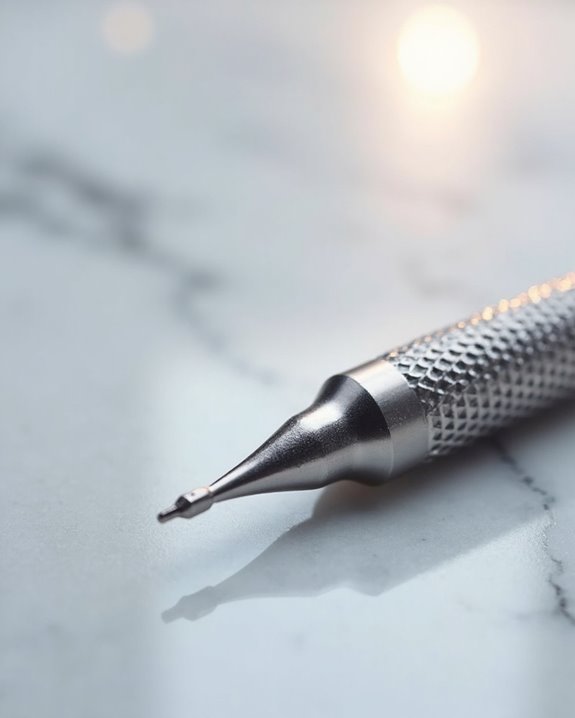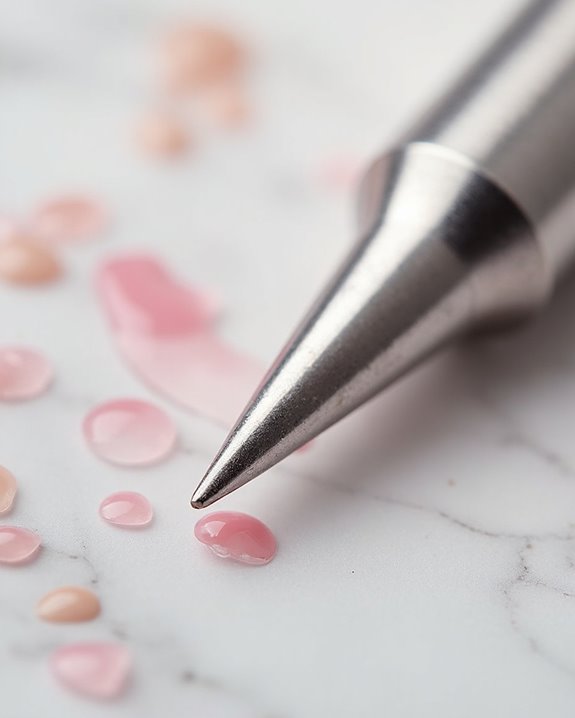If you’re looking for the best nail drill bit for buffing nails, opt for a ceramic bit due to its gentle, effective performance. Ceramic bits, known for reducing heat buildup and dust, guarantee comfort during use, while their durability suits natural or acrylic nails. They work best at low speeds, around 5,000-10,000 RPM, with fine grits like 180-240, preventing damage and offering a smooth finish. Stick with us to uncover more useful insights.
Key Takeaways
- Opt for fine grit bits (180-240) for gentle smoothing and minimal damage during buffing.
- Choose ceramic bits to reduce heat buildup and ensure comfortable buffing sessions.
- Use tapered barrel bits for precise control and even coverage on nail contours.
- Select felt bits for a smooth, polished finish without excessive abrasion.
- Prioritize low speed (5,000-10,000 RPM) and light pressure for safe buffing.
Understanding Nail Drill Bits for Buffing
How can you choose the right nail drill bit for buffing to achieve a smooth, professional finish? When selecting a Nail Buffer tool, you’ve gotta consider shapes like the Tapered Barrel, which offers precise control for even coverage, especially on curved nail edges, and guarantees a Smooth Top surface with minimal effort. Opt for a Ceramic Nail Drill bit with Medium grit for durability and precision, particularly when smoothing hard skin or calluses, as it reduces Heat build-up during extended use.
Alternatively, a Carbide Bit can work well for tougher tasks, providing strength and consistency, while its fine grit options prevent damage to natural nails. Make sure you’re matching the bit’s material and grit to your specific buffing needs for best results. For precision in curved areas like cuticles, ball-shaped bits offer versatility and ease of maneuvering.
Benefits of Using the Right Buffing Bit
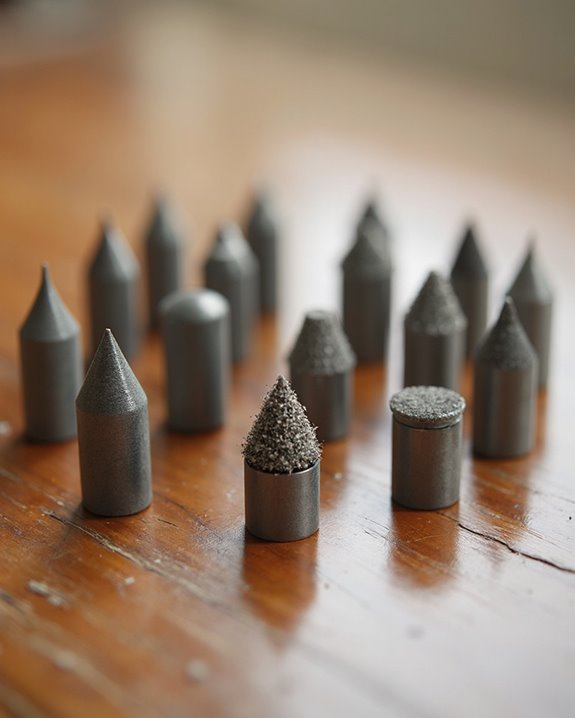
Selecting the ideal nail drill bit for buffing, as explored earlier, sets the stage for understanding the significant advantages of using the right tool for the job. When you choose a high quality bit, like one made of durable carbide, you’re ensuring a long lasting solution that’s great for surface work, smoothing the nail surface with precision, and removing imperfections effectively. This prevents harm, allowing you to work without damaging your clients’ nails, while achieving a professional finish.
Moreover, using the right bit saves you time, as it efficiently prepares the nail surface for polish, ensuring even application. It also promotes hygiene, since a high quality bit can be sterilized, reducing risks and maintaining safety between sessions.
For instance, ceramic bits generate less heat and dust, enhancing comfort during extended manicure sessions.
Materials Suited for Buffing Nails
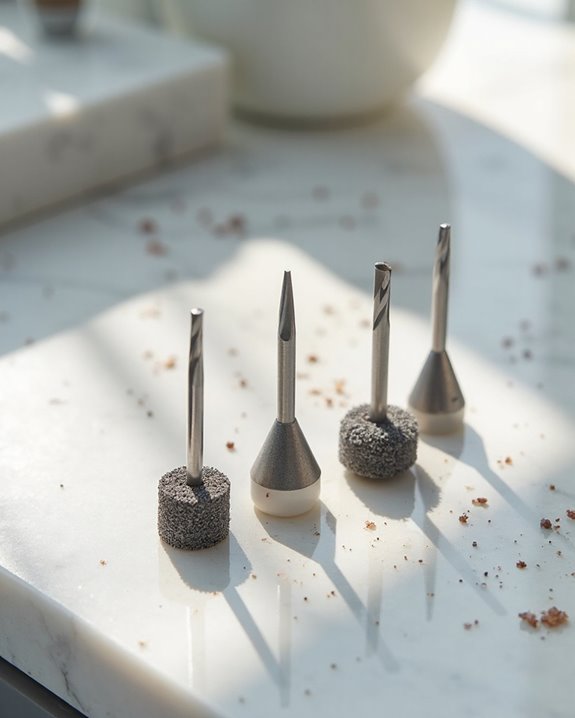
When it comes to buffing nails, understanding the best materials for nail drill bits can make a significant difference in achieving a smooth, professional finish. You’ll find that Tungsten Carbide, used in Carbide bits, offers fine grit options for a Carbide Nail Drill, providing controlled abrasion for a polished look without overheating your nails. With an Electric file, these Bits guarantee precision, especially when paired with Sanding bands on a Mandrel Bit, which deliver versatile buffing for gel or natural nails, allowing consistent smoothing across surfaces.
Additionally, materials like silicone, ceramic, and diamond in other Bits work well for buffing, each offering unique durability and gentleness. By choosing wisely, you’re guaranteeing effective results, protecting nail integrity, and enhancing your manicure process. Diamond Bits offer versatility for smoothing, shaping, and polishing acrylic surfaces, making them ideal for all skill levels.
Key Shapes for Effective Buffing

Beyond the importance of materials in nail drill bits, it’s just as essential to focus on the specific shapes that can enhance your buffing results for a flawless manicure. When you’re choosing a bit, consider the Tapered barrel, which, with its flat-top design, offers precision for surface work and cuticle prep, often in fine grits for gentle smoothing. The Cone-shaped bit, ideal for tight areas, allows targeted buffing near cuticles, ensuring smooth finishes without irritation. Don’t overlook the Smooth top barrel for even product removal, or the Small barrel for natural nail shaping without damage. Finally, a Pear-shaped bit, often a Carbide Drill, excels in gentle polishing, making it a versatile tool for your buffing needs.
Grit Levels and Their Impact on Buffing
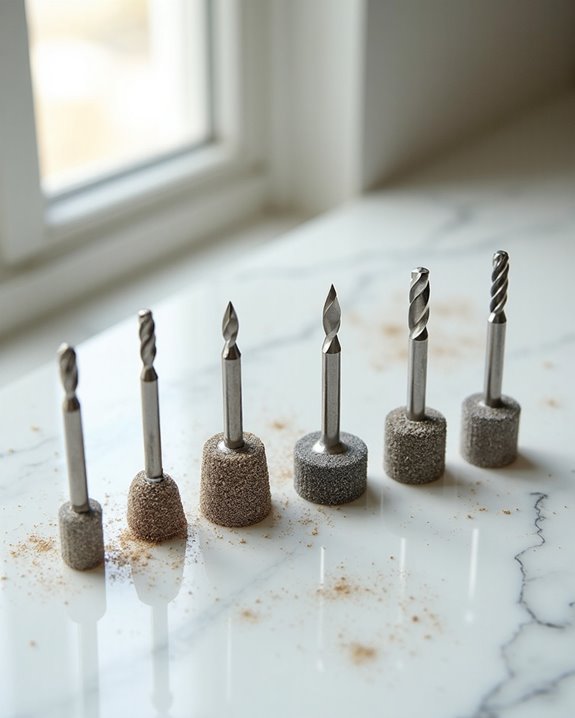
Grit selection plays a pivotal role in achieving ideal buffing results, as the level of abrasiveness in a nail drill bit directly affects how smoothly and safely you can refine the nail surface. When using a coarse bit, you’ll notice that coarse grits, with larger abrasive particles, can remove too much material quickly, risking nail thinning or uneven finishes. Instead, opt for finer grits in your Nail Drill, as they gently smooth the surface without damage, ensuring precision on natural nails with high ratings like 4.8 stars.
Different types of grits impact your buffing efficiency, so avoid using a coarse approach for final polishing. A medium bit offers balance, addressing minor flaws, while finer options create a polished shine for perfect results.
Silicone Bits: A Top Choice for Buffing
Moving from the importance of grit levels, let’s explore why silicone bits stand out as a top pick for buffing nails with a nail drill. As a user, you’ll find these nail drill bits, made of soft, flexible material, ideal for gently smoothing your nail surface, ensuring a polished finish without harm. They’re great for removing minor imperfections, perfect for cleaning around the cuticle area without damaging delicate skin, and come in different shapes to suit various tasks.
With silicone bits, you’ve got a safer option that minimizes heat buildup, allowing controlled buffing on sensitive nails, while maintaining health and shine. Their versatility, suitable for beginners and pros alike, makes them a top choice for preparing any nail for polish or designs.
Comparing Buffing Bits for Different Nail Types
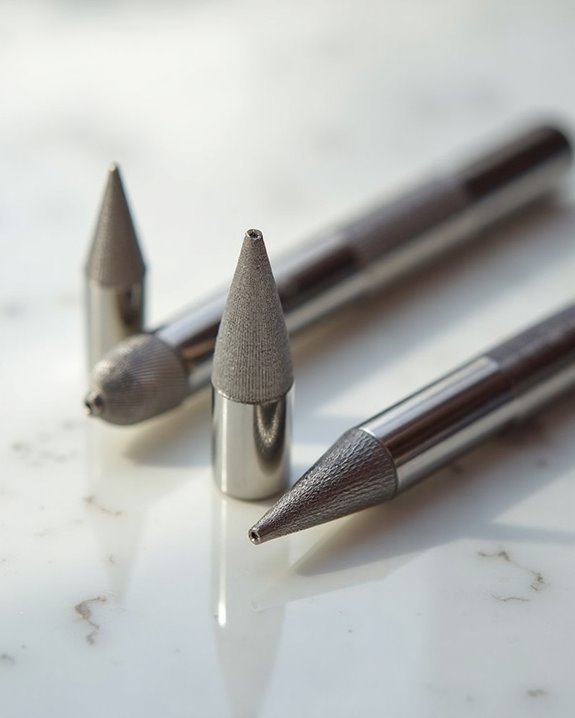
As we delve into comparing buffing bits for different nail types, it’s important to understand that not every bit suits every nail structure, and selecting the right one can greatly impact your results. When working with natural nails, you’ll find softer nail drill bits, like fine grit ceramic, offer gentle smoothing, reducing damage to sensitive surfaces with precise control. For acrylic nails, opt for medium grit options like the Top Large Barrel Carbide, made of carbide, which guarantees durability and even buffing, preventing overheating during use. If you’re handling gel polish on gel nails, diamond bits with fine grits excel, providing a polished finish on harder textures, while their abrasive design minimizes excessive pressure, guaranteeing a safe, effective process.
Tips for Selecting a Buffing Bit

How can you guarantee you’re picking the right buffing bit for your nail care routine? When focusing on buffing, start by selecting a fine grit bit, like extra fine or fine, which offers gentle smoothing without damaging nails, guaranteeing a polished finish with minimal risk. Consider a tapered barrel shape, ideal for surface work and precision, as it allows you to navigate nail contours effectively for consistent results.
Next, look at materials like ceramic bits or diamond bits, with ceramic reducing heat during use and diamond providing lasting durability, both enhancing buffing efficiency. Check the shank size, guaranteeing a standard 3/32” fit for compatibility with your drill. Finally, invest in quality bits from reputable sources, guaranteeing even performance and longevity.
Proper Techniques for Buffing With Drill Bits
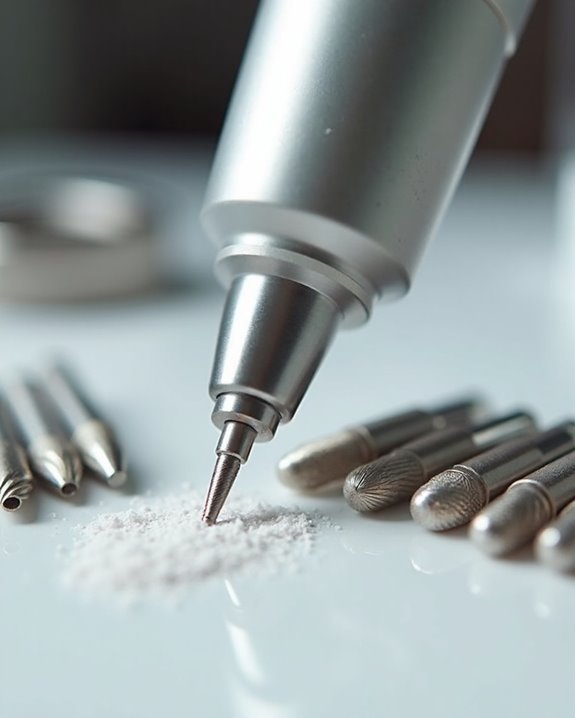
Once you’ve selected the right buffing bit for your nail care needs, it’s time to focus on mastering the techniques for using it effectively with a nail drill. Start with fine grit nail drill bits, ideally extra fine or fine tungsten carbide options, to gently smooth nails without burning or cutting, ensuring you avoid lifting the natural nail plate or damaging your client’s nail. Begin at a low speed, around 5,000-10,000 RPMs, gradually increasing as needed, while moving the bit back and forth to prevent heat buildup.
Use light pressure with flame bits, often used to remove excess product, and incorporate a cooling method, like warm water, to reduce friction. This keeps the process safe, controlled, and effective for best results.
Maintenance and Care for Buffing Bits
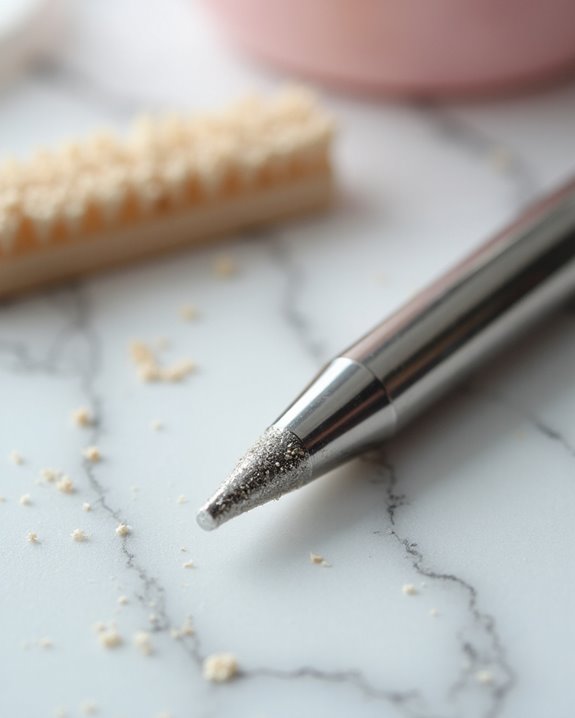
Start prioritizing the maintenance of your buffing bits to guarantee they remain effective and safe for every nail care session. After each use, grab a Cleaning Brush to sweep away debris, then wash with mild soap and warm water to remove product and dead skin, especially to clean under the nail. For Cleaner Safety, sanitize metal bits in a liquid disinfectant like isopropyl alcohol, soaking the bits in a liquid for 1-2 minutes to kill bacteria, but avoid prolonged exposure to prevent material erosion.
Next, store your bits in a dry, covered container to shield them from dust and moisture, preserving their grit. Finally, inspect them regularly for wear, replacing dull bits every few months to guarantee best performance.
Frequently Asked Questions
Which Nail Drill Bit Is Used for Shaping?
Hark, ye olde nail enthusiast! When shaping nails, you’ll love using carbide bits for Shaping Techniques and Nail Contouring. Their Bit Designs aid Edge Profiling, Symmetry Methods, and Tool Innovations. Try Practice Drills today!
How to Know Which Nail Drill Bit to Use?
Hey, figuring out how to know which nail drill bit to use ain’t hard! Follow Expert Advice and a Beginner Guide. Check Tool Compatibility, Cost Factors, Durability Check, Storage Methods, and Usage Scenarios.
What Grit Is Best for Buffing Acrylic Nails?
Hey, you’ve gotta know the best grit for buffing acrylic nails! It’s a game-changer for Acrylic Smoothness and Nail Polishing. Choose fine Grit Alternatives for Buffing Safety, Grit Durability, Acrylic Shine, and flawless Buffing Techniques.
What Do the Different Colors on Nail Drill Bits Mean?
Hey, you’re curious about what different colors on nail drill bits mean! Color Symbolism, Bit Hues, Marking Interpretations, Shade Functions, Indicator Colors, Tinting Meanings, and Chroma Codes guide you in selecting the right grit.


